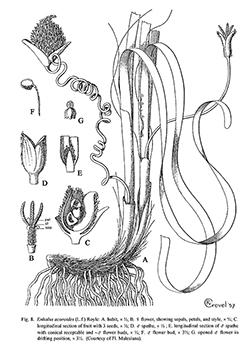e-Flora of Thailand
Volume 7 > Part 3 > Year 2001 > Page 369 > Hydrocharitaceae > Enhalus
Enhalus acoroides (L.f.) Roylewfo-0000770776
Ill. Bot. Himal. Mts. 453. 1840; Hartog, Sea-grasses of the World, 214, f. 60. 1970; Beijing, Fl. Reipubl. Popularis Sin. 8: 167, f. 65. 1992.— Stratiotes acoroides L.f., Suppl.: 268. 1781. Fig. 8.
Accepted Name : This is currently accepted.
Synonyms & Citations :
Description : Rhizome to 1.5 cm diam. Roots numerous, 10–20 by 3–5 mm. Leaves 30–150 by 1.2–1.8 cm, apex rounded to obtuse, margins thickened by coarse, tough vascular bundles that persist following decay of leaves. Inflorescence pedunculate; staminate peduncles 5–10 cm long; carpellate peduncles 40–50 cm long, persistent, coiling following pollination. Staminate flowers pedicellate; pedicel 3–13 mm long; sepals 3, white, reflexed, ca 2 mm long; petals 3, white, broader than sepals, erect, ca 1.8 mm long; stamens 3, erect. Carpellate flowers sessile; sepals 3, reddish, margins recurved; petals 3, white; ovary densely covered with long fringe-like pubescence. Fruit 5–7 cm long, green, apex acuminate. Seeds 1–1.5 cm long.
Thailand : PENINSULAR: Phuket.
Distribution : As the genus.
Ecology : Shallow, sheltered sea coasts from low tide mark to depths of 4 meters. Flowering: only occurs in areas where the plants are periodically exposed during spring.
Vernacular : Am phan daeng (อำพันแดง), am phan hang nu (อำพันหางหนู), hua ngu thale (หัวงูทะเล)(Peninsular).

